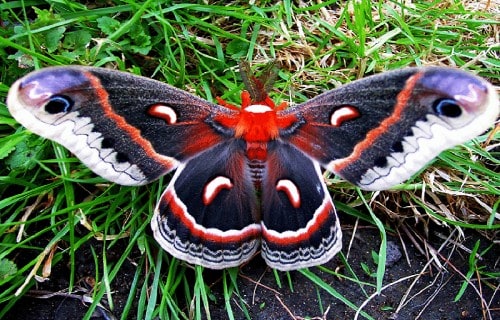
It’s our great hope that each of you, our readers, will fully enjoy and appreciate this article about the 6 Magnificent Moths of Canada. We certainly enjoyed compiling the information for you. May it both educate and enlighten about such natural marvels.
Naturally, though, the few species presented herein represent only a small percentage of the similar creatures in this region. We do believe, however, that they serve as excellent representatives of the Order. You will also find similar species amongst our other articles.
Luna Moth
Luna Moth Facts
- Leading off this article about these 6 Magnificent Moths of Canada we present the out of this world insect known as the Luna Moth.
- This stunning variety of Lepidoptera bears the common name due to its appearance. It also holds the comparatively short and simple scientific name, however, of the Actias luna. By either term, though, it represents a fabulous and fascinating creature.
- Like many of its kindred, it owes its scientific name to one of the best known of early researchers. In this case, that’s the renowned Swedish botanist and zoologist, Carl Linnaeus. He made the first official recognition of it as a separate species in 1758.
- That wasn’t its first discovery, however. In point of fact, it holds a place of moderate historical importance in the annals of science. That’s because of its earliest recognition. While Carl Linnaeus gave it its first formal recognition, it was first noted in 1700.
- That fact made it the first insect of its kind to be described in any way in scientific literature. It also holds yet another distinction, though. The invertebrate, in point of fact, easily ranks as one of the largest moths found anywhere in its native range.
- This magnificent Lepidoptera also holds yet another status in the local popular culture of a specific portion of its range. This occurs due to the fact that the arthropod appeared on a first-class postage stamp in the United States, issued in June 1987.
- For the moment, the Luna Moth appears to be maintaining a stable and sufficient population base. The IUCN, therefore, presently lists it as Least Concern. It nonetheless does face some threats. These include habitat loss and climate change.
Luna Moth Physical Description
Though not its only distinctive feature, the magnificent Luna Moth nonetheless does impress one due to its sheer size. In point of fact, it ranks as one of the largest of all Lepidoptera, in terms of wingspan. That size varies greatly among individuals, however.
The invertebrate further displays a slight degree the the physiological trait of sexual dimorphism. In its specific case, though, this has nothing to do with physical size. Instead, this manifests itself in the fact that the antennae of the male grow longer and wider.
Otherwise, the genders remain remarkably similar in appearance. Both sexes attain an average wingspan measuring roughly 4.5 in (11.4 cm). Some exceptional individuals, however, reach a span of as much as 7 in (17.8 cm). These giants truly distinguish themselves.
Regardless of their span, though, the wings of the breathtaking Luna Moth deserve appreciation for their mere appearance. That’s because of their striking and unique coloring. This consists of a bright lime-green background, offsetting the mainly white body.
The wings also display yet another distinctive characteristic. More precisely, the hindwings stand out. These features develop as highly elongated in shape. This remarkable evolutionary trait only serves to separate and distinguish the species from its brethren even more.
- Kingdom: Animalia
- Phylum: Euarthropoda
- Class: Insecta
- Order: Lepidoptera
- Family: Saturniidae
- Genus: Actias
- Species: A. luna
Luna Moth Distribution, Habitat, and Ecology
The visually unique and stunning Luna Moth, quite fortunately, has an advantage over many related creatures. That’s due to the fact that it inhabits a comparatively extensive range of the world. Yet at the same time, that habitat range qualifies as very specific.
In point of fact, it makes it evolved as native a very specific portion of the continent of North America. More precisely, it inhabits a large portion of the eastern half of the United States. This extends from Florida to Maine and a small portion of extreme northeast Canada.
Within this range, though, the magnificent Lepidoptera exhibits a relatively great degree of flexibility and adaptability in terms of habitat. As a result of this versatility, it inhabits various types of habitats, providing a sufficient number of certain types of plants are present.
Like most of its kind, the Luna Moth evolved as nocturnal in nature. Flying at night, females release powerful pheromones, to attract the males. These the males detect with their sensitive antennae. They can further do so from as great a distance as several miles.
Although adults do not feed for the duration of the life cycle, the larvae feed voraciously, typically on the same tree their cocoon was place on. It also feeds primarily on several varieties of broadleaf trees and is itself mainly preyed upon by bats and various birds.
Eight-Spotted Forester Moth
Eight-Spotted Forester Moth Facts
- Next up in this article about these 6 Magnificent Moths of Canada comes the uniquely-marked beauty named the Eight-Spotted Forester Moth.
- This magnificent Lepidoptera is most commonly referred to by the somewhat cumbersome because it fits perfecctly. For the moment, unlike many of its related species, this marvel has no other generally accepted common name.
- Professional researchers, meanwhile, typically refer to the insect by its official scientific name. That term, however, doesn’t really roll off the tongue much more easily. That’s because it’s scientific name is the equally hard to pronounce Alypia octomaculata.
- The Arthropod received that name at the hands of the renowned Danish researcher Johan Christian Fabricius. The respected zoologist made the first formal recognition of it as a separate and distinct species. That noteworthy even occurred in 1775.
- This beautiful insect holds a better position than many. For the moment, this marvel of Nature appears to be maintaing a population base that’s both sizeable and stable. This further appears to hold true throughout the entirety of its natural range.
- The IUCN, therefore, currently has no listing for the Eight Spotted Forester Moth. Any such status would be reflected on the organization’s Red List of Threatened Species. That fortunate situation, however, could potentially change in the very near future.
- That’s due to the fact that, like most species, if not all, it faces potential threats to its existence. One of those consists of habitat loss, due to human expansion and activities. Its greatest potential threat, though, likely comes from ongoing climate change.
Eight Spotted Forester Moth Physical Description
The fabulous Eight Spotted Forester Moth actually often passes for a butterfly, among the non-professionals who encounter them. Indeed, the amazing invertebrate strongly resembles its cousins in terms of both behavior and general physical appearance.
Although it’s a truly impressive species, it doesn’t earn that accolade based on sheer physical size. That’s because it’s an average-sized member of its genus. It also displays no discernible amount of the physiological characteristic known as sexual dimorphism.
Individuals of both genders therefore appear virtually identical to the naked eye. In terms of size, mature specimens attain an average wingspan of roughly 1 – 1.5 in (2.5 – 3.8 cm). Exceptional individuals do occur, of course, but these remain extremely uncommon.
The overall coloring of adult examples of the Eight Spotted Forester Moth remains principally black. Various parts of the wings do, however, display small variations in this pattern. The body, meanwhile, generally remains almost entirely black in coloring.
The wings of the Arthropod, though, do show some spots of color. Each forewing manifest two light yellow spots. The hindwings also each display two spots, these being white in color. Patches of bright orange hairs also develop on both the front and middle pair of legs.
- Kingdom: Animalia
- Phylum: Arthropoda
- Class: Insecta
- Order: Lepidoptera
- Family: Noctuidae
- Genus: Alypia
- Species: A. octomaculata
Eight Spotted Forester Moth Distribution, Habitat, and Ecology
Regrettably, the stunninig Eight Spotted Forester Moth inhabits a moderately restricted swathe of the globe. That range also has a highly broken nature to it. For the moment, no evidence exists to indicate that it ever possessed a more extensive range.
This inspiring creation of Nature and evolution evolved as native to a limited portion of North America. Its population mainly appears in the eastern portion of the United States. Smaller groupings, though, also appear in parts of the countries of Canada and Mexico.
Even within its native range, this Lepidoptera has very specific requirements for its choice of habitat. The vast majority of adults appear in the narrow zone where wooded areas meet open areas. This unique placement serves to meet two of its principal needs.
That’s due to the dietary needs of both its adult and larval forms. The open areas provide the adults with quantities of flowers, from which they feed on the nectar they require. The larva, meanwhile, find the specific plants upon which they feed in the wooded areas.
Adults of the Eight Spotted Forester Moth most commonly appear in the Spring. In warmer regions, two lifecylces occur per year. The dense, forested regions also provide the adults with sufficient foliage for the laying of their eggs, typically under the leaves.
This natural wonder truly stands out from most of its relatives due to its behavioral patterns. That’s due to the fact that, unlike most moths, it flies during the daytime. Its feeding activities further serve as a source of pollination for the many various flowers in its area.
Cecropia Moth

Cecropia Moth Facts
- Appearing the third spot in this compilation of 6 Magnificent Moths of Canada, the Cecropia Moth does so only due to random selection.
- This stunning variety of Lepidoptera goes by a relatively simple common name. That, however, is a surprisingly non-descriptive term. The scientific name for it, meanwhile, remains that of the tongue-twisting term of Hyalophora cecropia.
- Regardless of which name one chooses to use to refer to it, though, one fact stands out. That’s because the marvel of Nature never fails to impress those who see it. The first known scientific recognition of the arthropod occurred in the year 1758.
- That occurred due to the work of a highly respected individual. None other than the renowned Swedish botanist Carl Linnaeus made that fateful acknowledgement. He first did so, in fact, in his 10th edition of his Systema Naturae, at that time.
- For the moment, it thankfully appears to be maintaining a large and stable population base. This trend further seems to hold true throughout the entirety of its natural range. The IUCN, therefore, presently has no listing for it on its Red List.
- The magnificent Cecropia Moth nevertheless does face the same potential threats as other species. One of those consists of the ever-present danger of habitat loss. Its greatest threat, though, obviously comes in the form of climate change.
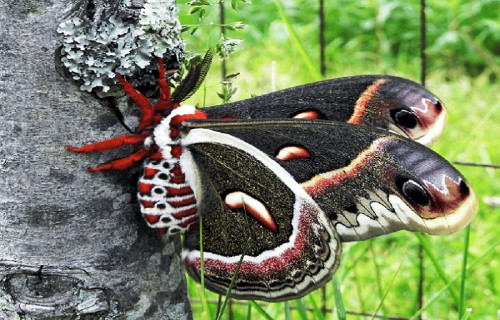
Cecropia Moth Physical Description
The dazzling Cecropia Moth actually manages to impress those who encounter it in a variety of ways. That’s because it evolved to be both beautiful and large for its kind. In fact, it ranks as the largest known variety of moth native to its portion of the globe.
Like many of its relatives, it also displays the physiological trait of sexual dimorphism. In its particular case, this characteristic manifests itself in terms of both size and appearance. The size difference, furthermore, in fact qualifies as relatively extreme.
Females attain an average wingspan of around 6 in (15.2 cm). Exceptional individuals, however, sometimes reach 7 in (17.8 cm). Males, meanwhile, average only a 4 in (10 cm) wingspan. Only the smaller bodied males possess large, feathery antennae.
The fabulous Cecropia Moth also display a dazzling pattern of colors. While the genders differ in other manners, in this both sexes present the same appearance. Both show a bright array of colors. These typically include red, brown, black, white, and orange.
- Kingdom: Animalia
- Phylum: Arthropoda
- Class: Insecta
- Order: Lepidoptera
- Family: Saturniidae
- Genus: Hyalophora
- Species: H. cecropia

Cecropia Moth Distribution, Habitat, and Ecology
The gorgeous Cecropia Moth, fortunately, evolved as native to an extremely broad swathe of the world. In fact, its range ranks as the broadest of any moth in its part of the world. That portion of the globe, furthermore, covers a majority of the continent of North America.
Within that portion of the world, the insect makes its home across parts of the countries of the United States and Canada. In the United States, its area of habitation extends from the Rocky Mountains eastward. To the north, it extends as far as northern Canada.
Wherever it appears, though, it displays decided preferences for its choice of habitat. That’s due to the fact that the great majority of individuals make their home on maple trees. If these aren’t available, however, individuals sometimes appear of birch or cherry trees.
Like the majority of moths, it evolved as nocturnal in nature. During their short lifespans, utilize their furry antennae to track females via their powerful pheromones. The males typically die shortly after mating, while the female lives until she lays her eggs.
Like most moths, the short-lived adults of the Cecropia Moth possess no mouth parts, thus do no feed at all. These therefore pose no threat to any species. Unfortunately, though, they themselves have many predators, including bats and various parasites.
Hemlock Looper
Hemlock Looper Facts
- Next up in this compendium of 6 Magnificent Moths of Canada we give you, our readers, the remarkable species known as the Hemlock Looper.
- This delicate marvel of Nature, an excellent example of native Lepidoptera, most frequently goes by this name due to its nature. The invertebrate also has another, though less used common name. That’s the term of the mournful thorn.
- Professionals, however, typically refer to it by yet another name. That’s the technical name for the small species. Unfortunately, however, like many such terms, its’ rather hard to pronounce. That’s due to the fact that it’s also called the Lambdina fiscellaria.
- The respected French entomologist, Achille Guenée, assigned this tonge-twisting formal name. He made the first known official recognition of the insect as a separate and distinct species. This scientifically noteworthy event further occurred in 1857.
- Regrettably, though, in some parts of its native range, it’s viewed as a serious pest. That holds true due to the feeding habits of its caterpillar form. When present in sufficient numbers, these pose a serious threat to several varieties of trees in local area.
- For the moment, this impressive invertebrate appears to be maintaing a population base that’s both sizeable and stable. This also seems to hold tue throughout the entirety of its natural range. The IUCN, therefore, presently has no listing for it on its Red List.
- The Hemlock Looper nevertheless should be considered as facing several threats to its continued existence. Habitat loss, chiefly due to human activities, naturally constitutes a potential danger. Its greatest threat, however, comes from climate change.
Hemlock Looper Physical Description
The appealing Lepidoptera known by the attention-grabbing common name of the Hemlock Looper garners some attention due to its dietary habits, to be sure. Yet the remarkable insect also merits its own degree of appreciation due to its sheer visual appeal, too.
It further manages to earn a certain degree of appreciation for its natural beauty alone. Its physical size isn’t a factor in that particular aspect. That’s because it remains only an average-sized specimen of its kind, unlike some giants, like the Giant Atlas Moth.
More specifically, mature adults of the species possess an average wingspan of roughly 1.4 in (3.5 cm). Exceptional individuals do occur occasionally, of course. These uncommon specimens, however, rarely exceed this measurement by more than a small fraction.
Unlike many of its relatives, though, the Hemlock Looper displays no noticeable degree of the physiological characteristic of sexual dimorphism. This lack of distinguishing traits between the genders further includes both sheer size and physical appearance.
Adults of both genders therefore present the same general pattern of colors, as well as size. This principally manifests as a cream colored background over most of the body and wings. Thin, dark lines, however, generally also cross both the forewings and hindwings.
- Kingdom: Animalia
- Phylum: Arthropoda
- Class: Insecta
- Order: Lepidoptera
- Family: Geometridae
- Genus: Lambdina
- Species: L. fiscellaria
Hemlock Looper Distribution, Habitat, and Ecology
Fortunately, both for the Hemlock Looper itself, and those of us who appreciate Nature, it evolved as native to a relatively wide section of the globe. That’s due to the fact that the Arthropod evolved as native to much of the continent of North America.
Within that vast area, though, its range extends as far north as the southern portions of the country of Canada. From there, it makes appearances throughout the United States. The range of the small moth does not, however, extend into the country of Mexico.
In both of the countries on the continent that it does appear in, though, the great majority of its numbers tend to live in the eastern half of the continent. In all regions, however, the creature typically makes its home in areas of either coniferous or deciduous forests.
Although the caterpillar froms feed on virtually every variety of tree in their habitat range, they do show certain preferences. As the common name implies, though, these show a strong preference for hemlock trees. Yet they consume most others, as well as some shrubs.
Other than hemlock trees, the favorite food sources of the caterpillar form includes such indigenous tree species as white spruce, oak, and balsam fir. The mature adults, meanwhile, like many of their relatives, feed on the nectar of various local plant species.
The adult Hemlock Looper typically flies between August and early October, in most instances. After mating, the female lays large numbers of eggs, usually either in small groupings, or even singly. These she further places on bark, twigs, foliage, or even debris.
Isabella Tiger Moth
Isabella Tiger Moth Facts
- The fifth species making this listing of 6 Magnificent Moths of Canada is the visually impressive Isabella Tiger Moth.
- Most notably, the term given to it serves as the much more pronounceable common name for this beauty. Its scientific name, however, is that of the hard to pronounce term of Pyrrharctia isabella. Thankfully, though, the insect has others.
- This beautiful Lepidoptera, in fact, goes by several other common names. These different names include the banded woolly bear, the woolly bear, and the woolly worm. By whatever term one calls it, though, it represents a truly magnificent specimen.
- The first scientific recognition of this deceptively ordinary-seeming remarkable species occurred in the year 1797. At that time, the description occurred as the result of work done by the well known English botanist Sir James Edward Smith.
- Quite interestingly, this small moth also holds a small surprise for those just learning of it. That’s because it holds a position of moderate importance in the folklore of certain parts of its native range. This fact alone earns it a place of importance.
- The belief maintains that the relative percentage of different colors in its fur each year predicts the relative severity of the coming winter. Finally, and quite fortunately, unlike many of its relatives, the Isabella Tiger Moth appears to still have a stable population.
- The IUCN, therefore, currently does not have any listing for this species on its Red List of Threatened Species. Habitat loss could threaten it soon, however. The ongoing and escalating effects of climate change could also pose a danger in the near future.
Isabella Tiger Moth Physical Description
Perhaps most notably of all, the gorgeous Isabella Tiger Moth, like many related creatures, displays a moderate degree of sexual dimorphism. In the case of this species, that shows itself in terms of coloration. This principle, in fact, appears in many species of moth.
The adult males of this incredible arthropod generally display a primarily pale orange color. Females, meanwhile, typically display a predominantly rosy color. In terms of physical size, though, the genders of this marvelous insect remain essentially identical.
The overall wingspan, however, does vary somewhat significantly, without apparent regard for gender. As a result, mature adults attain a wingspan ranging from about 1.77 – 2.56 in (4.5 – 6.5 cm). This trait also distinguishes it from most of its related species.
The larval form of this fascinating invertebrate, though remain its best known form. That holds true because of the extreme size these attain, at least compared to similar creatures. Other species, such as the Regal Moth, also display this surprising physical trait.
This part of its life cycle averages about 2.25 in (5.7 cm) in length. Generally, the larvae display a covering of dense fur. This stage of the Isabella Tiger Moth typically presents a reddish-brown fur in the middle of the body, and black on the front and back of the body.
- Kingdom: Animalia
- Phylum: Arthropoda
- Class: Insecta
- Order: Lepidoptera
- Family: Erebidae
- Genus: Pyrrharctia
- Species: P. isabella
Isabella Tiger Moth Distribution, Habitat, and Ecology
Quite fortunately, the wonderful Isabella Tiger Moth inhabits a comparatively broad range of the globe. More precisely, however, this zone of habitation consists of parts of North America. More specifically, it mainly appears throughout most the continental United States.
The insect also inhabits the southern portions of Canada, though. Scattered individuals also appear as far north as the Arctic region, however. The small but amazing invertebrate further displays a relatively high degree of adaptability in its choice of habitats.
It is this versatility that helps it survive in areas of extreme cold. That holds true due to the fact that it appears in virtually any area with sufficient vegetation. It nonetheless demonstrates a decided preference for various trees, grasses, and certain flowers.
The larval form of the Isabella Tiger Moth typically emerges from the eggs in the late Fall season. Then, the caterpillar stage spends the winter quiescent, literally freezing solid. It then survives the freezing process due to an amazing evolutionary adaptation.
This astounding development of evolution involves the production of a natural protective chemical that prevents destruction of its tissues during the freezing process. Upon emerging from this self-imposed stasis in the spring, the caterpillar feeds voraciously.
At that time, the arthropod eats virtually any plant it finds. Individuals nonetheless do seem to prefer various grasses, as well as the foliage of trees such as birches, elms, and maples. Adults, however, only feed on the nectar of different types of flowers.
Giant Leopard Moth
Giant Leopard Moth Facts
- Closing out this composition about these 6 Magnificent Moths of Canada we present the aptly-named Giant Leopard Moth.
- Perhaps most worthy of note’s the fact that this Lepidoptera truly lives up to its name. That’s due to the fact that this magnificent Lepidoptera ranks as one of the largest in its native range. Its beauty and size, therefore both serve to impress.
- Professional researchers, however, know it by its scientific name. That term, though, remains somewhat hard to pronounce. More precisely, its official name on scientific records is that of the Hypercompe scribonia. A true tongue-twister, indeed.
- This insect further owes its scientific recognition as a separate species to a lesser-known individual. That less well known, but nonetheless respectable, researcher, was a Dutch naturalist. His acknowledgement of the species occurred in 1790.
- For the moment, the amazing Giant Leopard Moth stands out for yet another reason. That’s because it seems to be maintaining a stable and sufficient population base. That fortunate fact also appears to hold true throughout the entirety of its natural range.
- The IUCN, therefore, currently lists this remarkable invertebrate as Least Concern. This surprising status appears on the organizations’ Red List of Threatened Species. That status alone distinguishes the creature from a large percentage of its peers.
- The Lepidoptera nevertheless still faces various threats to its continued existence as a species, though. The danger of habitat loss remains a great danger to it, of course. Its greatest threat, however, comes from the ongoing effects of climate change.
Giant Leopard Moth Physical Description
The incredible Giant Leopard Moth clearly merits attention due to its sheer size, quite obviously. The insect also displays a moderate degree of the physiological characteristic of sexual dimorphism. It does so, however, in a very specific, and unusual manner.
Both genders of the astounding insect, firstly, attain an average wingspan of about 3 in (7.6 cm). That measurement alone distinguishes it from most other known Lepidoptera. The gender-based differences, though, manifest themselves in terms of overall length.
Males of the surprising species generally reach a length equaling about 2 in (5.1 cm). Females, though, achieve a much smaller average length. More precisely, in fact, these rarely exceed a body length of around 1.2 in (3 cm). This represents a relatively extreme difference.
The wings of the creatures, though, generally present the same general appearance. These usually present a bright white background, covered in a pattern of black blotches. Some of these are solid, yet some are hollow. Also, a few blue blotches often appear on the heads.
In contrast, the abdomen of the Giant Leopard Moth shows as significantly different. This part of the body shows bright colors. These usually include dark blue with orange markings for the abdomen. Males, however, often have a thin yellow line on the side of the body.
- Kingdom: Animalia
- Phylum: Euarthropoda
- Class: Insecta
- Order: Lepidoptera
- Family: Erebidae
- Genus: Hypercompe
- Species: H. scribonia
Giant Leopard Moth Distribution, Habitat, and Ecology
Yet another fact about the stunning Giant Leopard Moth separates it from the pack, so to speak. That’s its native range. This holds true due to the fact that this magnificent insect actually inhabits quite an extensive range. That zone of habitation remains specific, however.
It lives across a wide swathe of the Northern Hemisphere. More exactly, it primarily exists in a thin area of North America. This runs from Ontario, Canada, through the southern and eastern United States. Scattered populations also exist all the way to Panama.
In addition, it also displays decided habitat preferences. As a result, it prefers to inhabit various forest regions with host plants for caterpillars. It will, however, often inhabit woodlands, farmlands, gardens, and even public areas, opportunistically.
In its caterpillar stage, it feeds on a wide variety of host plants possessing broad leaves. These usually include honeysuckles, citrus, violets, magnolias, lilacs, and dandelions. The wonder of nature also feeds quite voraciously at this time, making it a pest to some people.
Fortunately, the Giant Leopard Moth has one more factor working in its favor. That’s the fact that this beautiful moth has very few natural predators. This holds true because both the spiny texture of its fur and the coloring of its wings dissuade most predators.
It’s also known for a distinctive trait. It often has protracted mating sessions, sometimes lasting for as much as 24 hours. Unlike many related species, its caterpillar stage does not sting. Its defensive measures usually only extend to rolling into a protective ball.
It does occasionally release a liquid in self-defense, however. This, emitted in small droplets, is a yellowish fluid which is harmless to humans. In this way, Nature provided this otherwise harmless beauty with the ability to defend itself quite effectively against threats.
6 Magnificent Moths of Canada

We sincerely hope that you have all thoroughly enjoyed reading, and hopefull learning from, this article about 6 Magnificent Moths of Canada. It’s our further hope that doing so has also left you with either a new or renewed appreciation for such wonders of Nature.
Sadly, though, many of their fellow denizens of the earth now find themselves facing severe threats to their continued existence. Indeed, many of these stem directly or indirectly from the actions of man. We must do all we can to protect and preserve these marvels.
Check out our other articles on 4 Perfecly Pleasing Palms, The Mighty Tornado, 3 Geologicial Wonders of Brazil, Earth’s 7 Rarest Butterflies, 5 Astonishing True Bugs
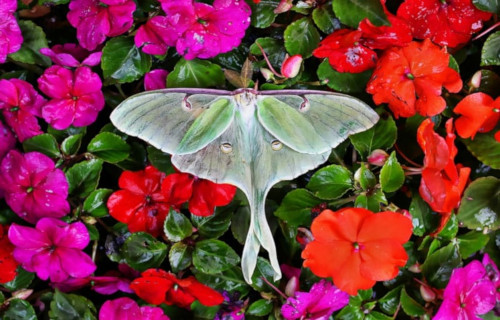
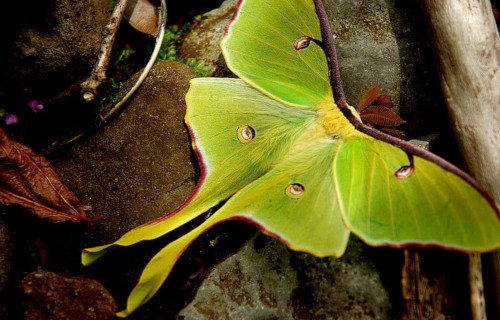
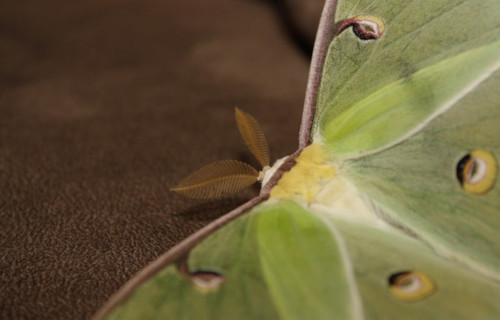
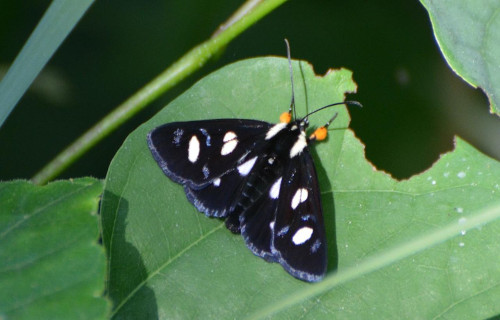
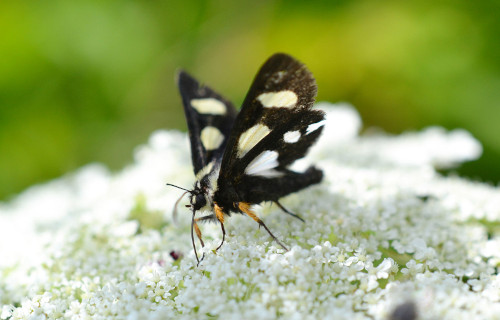
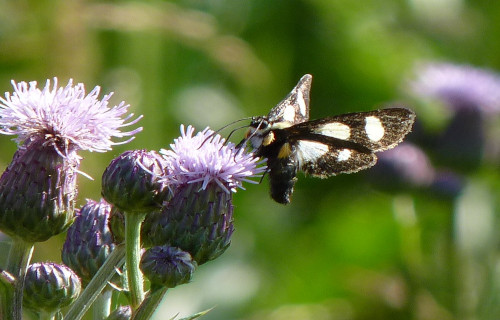
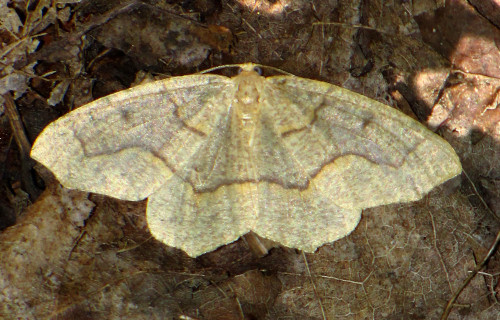
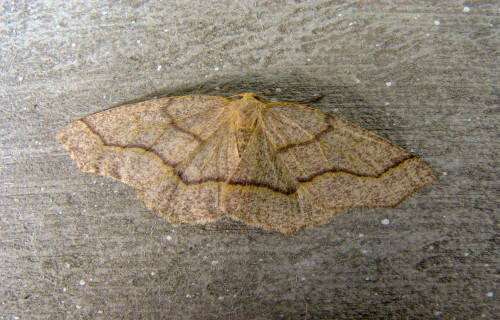
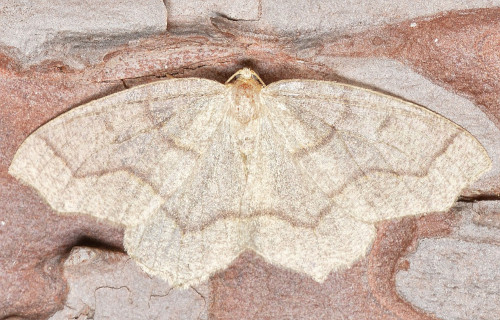
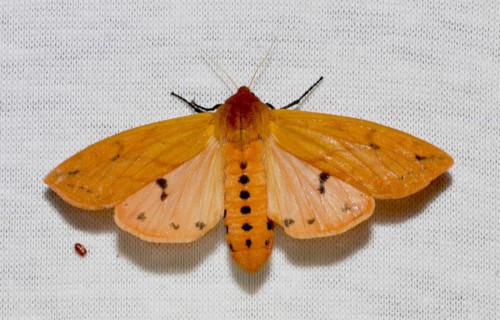
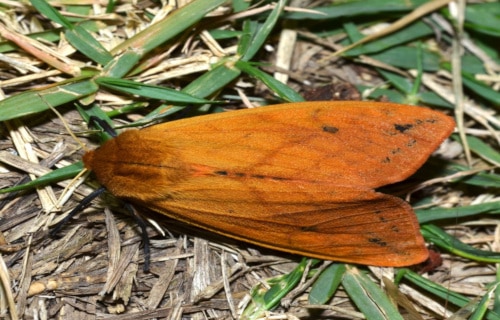
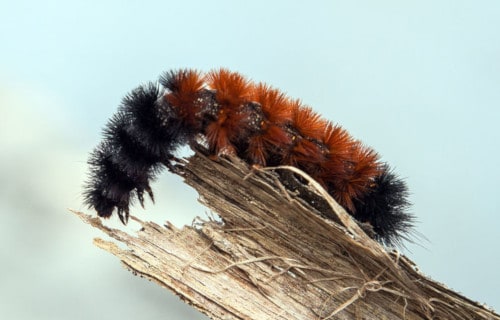
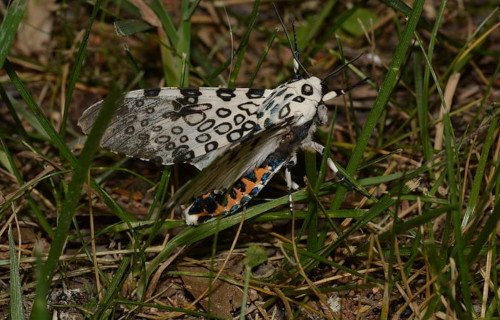
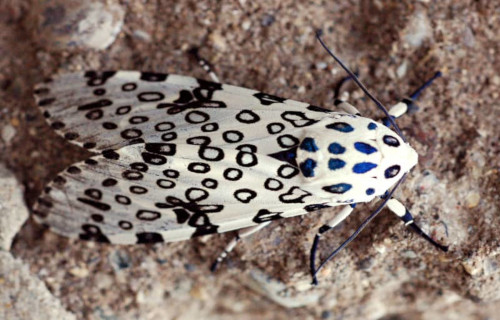
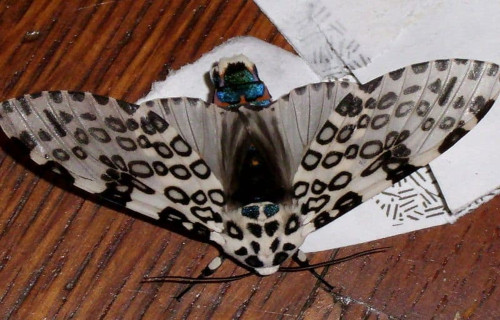









Leave a Reply